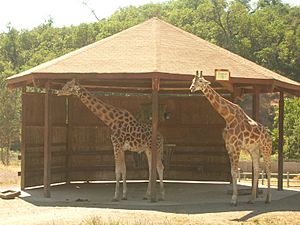Wildlife Safari facts for kids
 |
|
| Date opened | October 1972 |
|---|---|
| Location | 1790 Safari Road Winston, Oregon, U.S. |
| Land area | 615 acres (249 ha) |
| Coordinates | 43°08′30″N 123°25′35″W / 43.1417°N 123.4265°W |
| No. of animals | Over 600 |
| No. of species | Over 100 |
| Memberships |
|
Wildlife Safari is a special animal park in Winston, Oregon, USA. It's like a big adventure where you can drive your car right through areas where animals roam freely! This park covers a huge 615 acres, giving animals lots of space. You can see many different animals up close, like rhinos, giraffes, and elephants, as well as big birds. It's a fantastic place for taking pictures and learning about wildlife.
The park is divided into different areas, like Africa, Asia, and the Americas. In these areas, you'll mostly see large animals with hooves, like zebras and hippos. You can also drive past exhibits with bears, cheetahs, lions, and tigers.
Besides the drive-through part, Wildlife Safari has a free area called Safari Village. Here, you'll find shops, places to eat, and customer service. The village also has a petting zoo, camel rides (in season), and exhibits for reptiles and birds. You can walk on trails to see smaller animals too. Wildlife Safari is the only place in Oregon that has African elephants and maned wolves living there.
Wildlife Safari has been a member of the Association of Zoos and Aquariums (AZA) since 1986. This is a special group that makes sure zoos take good care of their animals. It's one of the few privately owned animal parks in the AZA. In 2021, it also got a special certification from the Zoological Association of America.
Contents
History of Wildlife Safari
Frank Hart, who often visited Africa, had an idea to create a safari park. It first opened in October 1972 and was called World Wildlife Safari. It was built on a large 600-acre piece of land.
However, the word "World" was removed from the name on June 9, 1974. This happened because another group, the World Wildlife Fund, asked them to change it to avoid confusion. In 1980, Wildlife Safari became a non-profit organization. This means it's run by a group called the Safari Game Search Foundation, and its main goal is to help animals, not to make money.
Amazing Animals at Wildlife Safari
Wildlife Safari is home to over 600 animals from more than 100 different species. Many of these animals live in large, open areas where visitors can drive through.
Animals from Africa
- African bush elephants: These huge elephants are not in the drive-through area.
- Ankole-Watusi cattle: These cows have amazing, large horns.
- Burchell’s zebra: You can see their unique stripes.
- Common eland: A very large type of antelope.
- Dromedary: These are camels with one hump.
- Reticulated giraffe: Look for their beautiful patterned coats.
- River hippopotamus: These large animals are not in the drive-through.
- Scimitar-horned oryx: These oryx have long, curved horns and are not in the drive-through.
- South African ostrich: The largest birds in the world.
- Southern white rhinoceros: See these impressive rhinos.
- White-bearded wildebeest: These animals are known for their big herds.
Animals from the Americas
- American black bear: These bears are not in the drive-through area.
- Barbary sheep: A type of wild sheep.
- Grizzly bear: These powerful bears are not in the drive-through.
- Guanaco: A relative of the llama.
- Plains bison: Large, shaggy animals that once roamed North America.
- Roosevelt elk: A large type of deer.
- Western pond turtle: Small turtles found in ponds.
Animals from Asia
- Blackbuck: Antelopes with striking black and white markings.
- Emu: Large, flightless birds from Australia.
- Fallow deer: Deer with spotted coats.
- Greater rhea: Large, flightless birds from South America.
- Nilgai: The largest Asian antelope.
- Sika: A type of deer from East Asia.
- White-cheeked gibbon: These apes are known for their loud calls.
- White-naped crane: Elegant cranes with white necks.
- Yak: Long-haired cattle from the Himalayas.
Other Fun Areas at Wildlife Safari
The Safari Village is a special part of the park that feels like a traditional zoo. It has smaller exhibits and lots of fun things to do.
Safari Village Attractions
- Safari Grill Event Center: A place for events and gatherings.
- Cheryl Ford Center: Another event space.
- Safari Grill: A place to grab a meal or a snack.
- Gift Shop: Where you can find souvenirs to remember your visit.
- Wells Fargo Australian Walkabout: This is a newer exhibit where you can walk right among animals from Australia! You might see wallaroos, black swans, and emus. There's also a Budgie Aviary where you can see many colorful budgies.
Conservation Efforts
Wildlife Safari is very involved in helping to protect animals. They have a very successful program for breeding cheetahs.
Cheetah Breeding Program
As of July 2021, Wildlife Safari's cheetah breeding program has helped bring 231 cheetah cubs into the world! These cubs are then sent to other zoos that are approved by the AZA. This helps to make sure that cheetahs, which are an endangered species, continue to thrive.
Wildlife Safari is recognized by animal welfare groups for how well they care for their animals. They focus on providing excellent conditions for all the animals living there.

